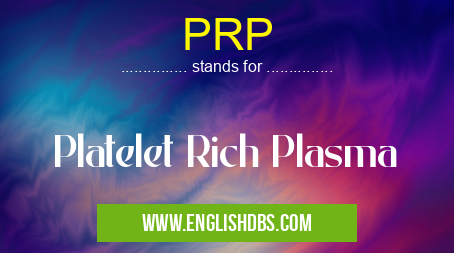What does PRP mean in HOSPITALS
Platelet Rich Plasma (PRP) is an emerging therapy in which a patient's own blood is used to treat various conditions. PRP involves using the body's own natural healing process to improve musculoskeletal function and treat a variety of other medical conditions.

PRP meaning in Hospitals in Medical
PRP mostly used in an acronym Hospitals in Category Medical that means Platelet Rich Plasma
Shorthand: PRP,
Full Form: Platelet Rich Plasma
For more information of "Platelet Rich Plasma", see the section below.
Essential Questions and Answers on Platelet Rich Plasma in "MEDICAL»HOSP"
What is PRP?
Platelet Rich Plasma (PRP) is an emerging therapy in which a patient's own blood is used to treat various conditions. The plasma component of the patient's blood contains high concentrations of platelets, which are cells that contain proteins called growth factors that stimulate tissue regeneration and healing.
How does PRP work?
PRP works by releasing growth factors that attract stem cells and new blood vessels to the area, promoting faster healing and repair. It also helps reduce inflammation, decrease pain, and improve range of motion. Additionally, it can be used to aid in tissue regeneration for certain medical conditions.
What types of injuries or ailments can be treated with PRP?
PRP has been used for many different musculoskeletal issues, such as sprains, tendinitis, plantar fasciitis, bursitis, rotator cuff tears, ACL tears and hip labral tears. It can also help relieve chronic joint pain resulting from osteoarthritis and degenerative disc disease and improve the appearance of acne scars.
What should I expect during the procedure?
During the procedure, a small sample of your blood will be drawn and placed in a centrifuge where it separates into its constituent parts — red-blood cells (RBCs), white-blood cells (WBCs), platelets, and plasma — on its way to forming platelet-rich plasma (PRP). Once complete, it will then be injected into the affected area along with local anesthesia or a corticosteroid if applicable.
Are there any side effects associated with PRP treatments?
As with any medical treatment there may be some minor side effects like swelling or bruising at the injection site for a few days afterward but these should subside within 7-10 days of treatment. There are no long term side effects associated with PRP treatments as only your body's natural substances are used during this procedure; however you may experience longer recovery times depending on your injury or condition being treated.
Final Words:
Platelet Rich Plasma (PRP) offers numerous benefits for those dealing with various conditions affecting their musculoskeletal system as well as for individuals looking for non-invasive cosmetic procedures such as scar reduction or hair restoration treatments. Although relatively new therapies are always met with skepticism due to lack of research supporting them, more studies are now confirming its efficacy making it a viable option for many people seeking relief from their symptoms without resorting to more invasive treatments.
PRP also stands for: |
|
| All stands for PRP |
